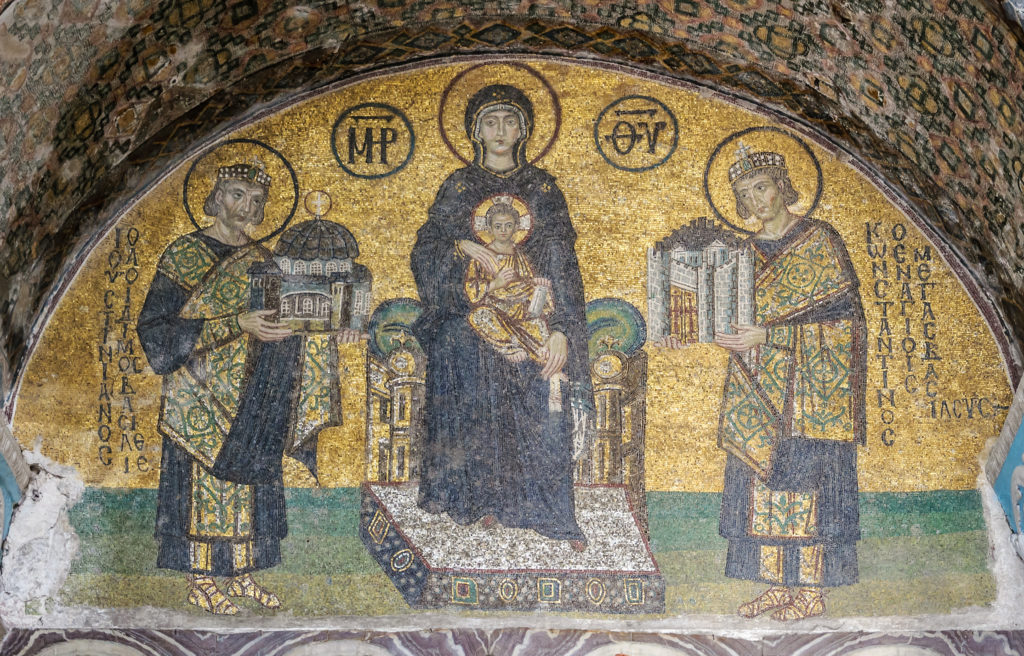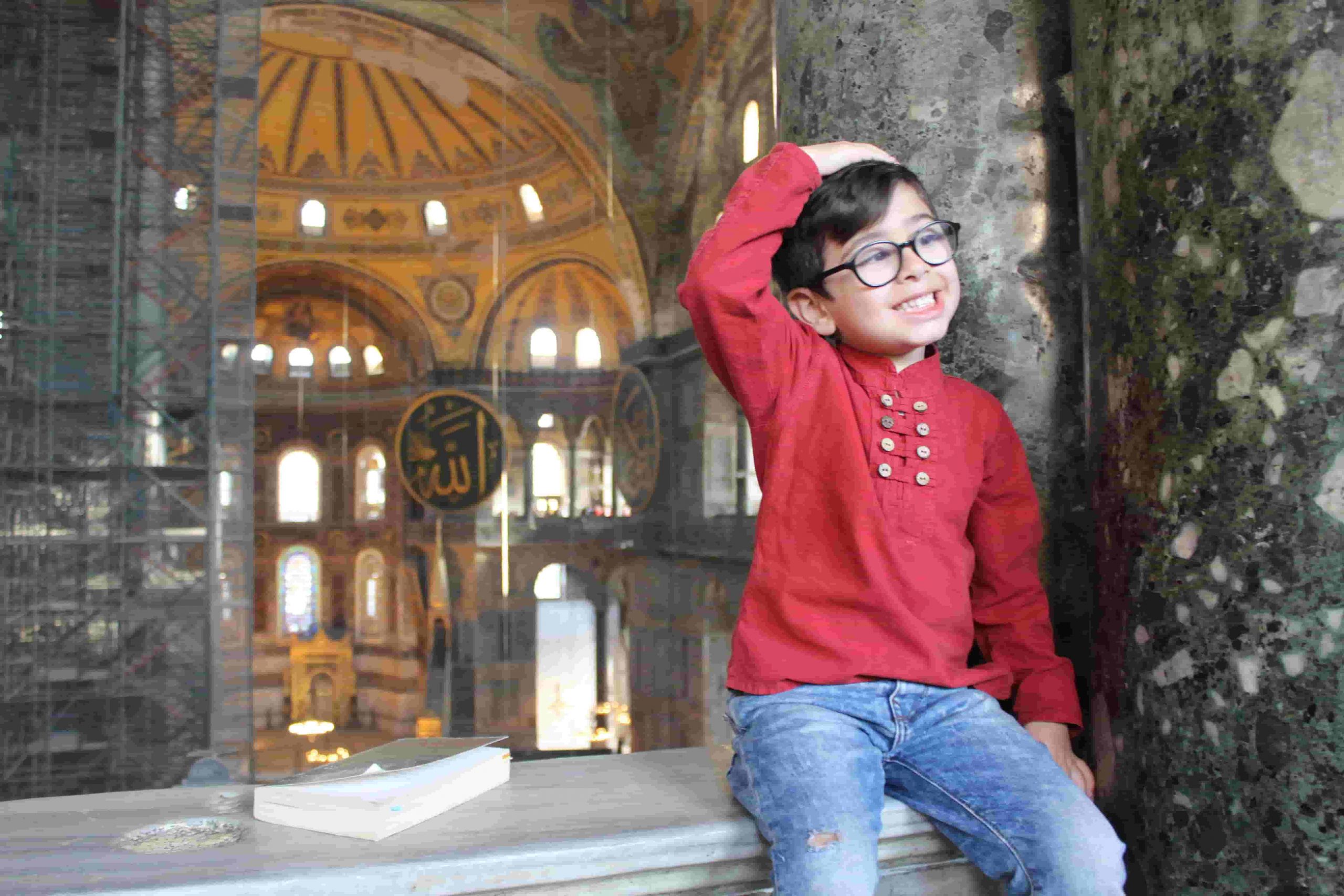The Hagia Sophia is a historic building in Istanbul, Turkey, that has served various roles over the centuries. Initially built as a cathedral, it was converted into a mosque, then became a museum, and is now a mosque again.
Its complex history and the blend of architectural styles make it a unique landmark. This guide will introduce you to the Hagia Sophia, provide a brief overview of its history, discuss its key features, and offer practical tips for visiting.
Hagia Sophia History and Facts
Brief History of Hagia Sophia (Ayasofya)
The Hagia Sophia, meaning ‘Holy Wisdom’, has a history spanning almost 1500 years. It was first constructed as a cathedral in 537 AD during the reign of Byzantine Emperor Justinian I. After Constantinople fell to the Ottomans in 1453, it was converted into a mosque, only to be transformed into a museum in 1935. In a testament to its enduring legacy, the Hagia Sophia was declared a mosque once again in 2020.
Some Hagia Sophia Facts You Need to Know Before Visiting

Architectural Wonder
The Hagia Sophia was the largest cathedral in the world for nearly a thousand years until Seville Cathedral was completed in 1520. Its vast dome, which appears to hover over the main space, was an engineering marvel of its time and is still admired today.
Byzantine Mosaics
Despite its conversion to a mosque, the Hagia Sophia retains many of its original Byzantine mosaics, some of which were uncovered during its time as a museum. These intricate designs depict scenes from Christian tradition and are remarkable examples of Byzantine artistry.
Islamic Additions
When the Hagia Sophia became a mosque, Islamic features were added, including minarets, a mihrab (niche indicating the direction of Mecca), and a minbar (pulpit). Many of these elements remain today, alongside the Christian mosaics, creating a unique blend of religious art and architecture.
Two Earthquakes
The current structure is actually the third Hagia Sophia. The first two buildings, constructed in the 4th and 5th centuries, were both destroyed by earthquakes. The present structure was completed in 537 AD.
The Weeping Column
There’s a column in the Hagia Sophia known as the Weeping Column. It is believed to have healing powers. People put their thumb into a hole in the column and believe that if it comes out moist, they are blessed with good luck.
Imperial Gate
The Imperial Gate, through which the emperor would enter, is decorated with intricate mosaics. The gate was used exclusively by the emperors during the Byzantine era.
Viking Graffiti
Among the various historical markings within the Hagia Sophia, there’s a piece of Viking graffiti. Carved into a balustrade on the second floor, it reads “Halfdan was here,” evidence of the varied visitors the monument has attracted over the centuries.
World Heritage Site
In 1985, Hagia Sophia was designated a World Heritage site by UNESCO. The organization describes it as a masterpiece of architectural genius.

Frequently Asked Questions
Can non-Muslims visit Hagia Sophia? Yes, non-Muslims can visit Hagia Sophia. It is open to visitors of all faiths. However, it’s important to note that it is currently functioning as a mosque, and respectful behavior and attire are expected.
What does the Hagia Sophia stand for? Hagia Sophia stands for ‘Holy Wisdom’ in Greek. It symbolizes the rich and diverse history of Istanbul, having served as an Orthodox cathedral, a Roman Catholic cathedral, a mosque, and a museum.
What is Hagia Sophia? It was originally built as a Christian cathedral in the 6th century during the Byzantine Empire but was later converted into a mosque in the 15th century when the Ottoman Empire conquered Constantinople (now Istanbul). It served as a mosque until 1935 when it was turned into a museum. In 2020, it was converted back into a mosque. Hagia Sophia is renowned for its stunning architectural design, blending elements of Byzantine and Ottoman styles. It features a massive dome, intricate mosaics, and grand interiors. It is considered a masterpiece of Byzantine architecture and a significant symbol of Istanbul’s history and cultural heritage.
Who built Hagia Sophia? Hagia Sophia was built by the Byzantine Emperor Justinian I and his architects Anthemius of Tralles and Isidore of Miletus. Construction began in 532 AD and was completed in 537 AD.
Why was Hagia Sophia turned into a mosque? Hagia Sophia was first turned into a mosque after the conquest of Constantinople by the Ottoman Turks under Sultan Mehmed II in 1453. It served as a mosque until 1935 when it was converted into a museum. As of 2020, it has once again been converted into a mosque.
What was the Hagia Sophia before Islam? Before it was converted to a mosque by the Ottoman Turks, Hagia Sophia was a Christian cathedral. It was originally an Eastern Orthodox cathedral and later a Roman Catholic cathedral.
Where is Hagia Sophia? Hagia Sophia is located in Istanbul, Turkey. It’s situated in the Sultanahmet district, which is the city’s historic heart.
What is it like inside the Hagia Sophia? Inside, Hagia Sophia is an architectural marvel with a large, impressive dome. It features a unique blend of Byzantine and Islamic art and architecture, including Christian mosaics and Islamic calligraphic roundels.
Can you go to the second floor of Hagia Sophia? Yes, visitors can access the second floor of Hagia Sophia, known as the gallery. It provides a closer view of the dome and mosaics, as well as a panoramic view of the nave below.
Why is the Hagia Sophia important to Christianity? Hagia Sophia is significant to Christianity because it was once the largest cathedral and the principal church of the Eastern Orthodox faith. Constructed in the Byzantine Empire under Emperor Justinian I, it represented the epitome of Christian architectural achievement at the time. Many important religious ceremonies and events were conducted here.
What happened to the Hagia Sophia in 1453? In 1453, during the Fall of Constantinople, the city was captured by the Ottoman Turks led by Sultan Mehmed II. Following the conquest, the Hagia Sophia was converted into a mosque. Christian mosaics and decorations were plastered over, and Islamic features like minarets were added.
What is the difference between the Blue Mosque and the Hagia Sophia? The primary difference lies in their history and architectural style. The Hagia Sophia was initially built as a Christian cathedral in the 6th century, whereas the Blue Mosque was constructed as an Islamic mosque in the 17th century. The Hagia Sophia is renowned for its massive dome and is a fusion of Byzantine and Islamic architecture, while the Blue Mosque is notable for its six minarets and beautiful blue Iznik tiles.
How did Muslims change Hagia Sophia? After the Ottoman conquest, the Hagia Sophia was converted into a mosque. Christian symbols and mosaics were plastered over or removed, and Islamic elements were added, including a mihrab (prayer niche indicating the direction of Mecca), a minbar (pulpit), and four minarets. The inscriptions of Allah, the Prophet Muhammad, and caliphs were also added on large roundels.
Practical Information

Opening Hours: The Hagia Sophia is open from 9:00 AM to 5:00 PM, with the last entry at 4:00 PM. It’s closed for visits during prayer times, so be sure to check the prayer schedule.
Entrance Fee: As of its status change to a mosque, entry into the Hagia Sophia is free.
Location: The Hagia Sophia is located in the Sultanahmet district of Istanbul. The area is well-served by public transportation and taxis, making it easily accessible.
Best Time to Visit: To avoid the biggest crowds, consider visiting the Hagia Sophia early in the morning or later in the afternoon.
Insider Tips: As Hagia Sophia is now a functioning mosque, visitors are expected to dress modestly. Women should cover their hair, and all visitors should cover their shoulders and knees. Non-Muslims are welcome outside prayer times, but some areas may be restricted.
Nearby Attractions: The Hagia Sophia is surrounded by other historically significant landmarks. Be sure to visit the Blue Mosque, Topkapi Palace, and the Basilica Cistern, all within a short walking distance.
Dress code for Hagia Sophia: As the Hagia Sophia is now functioning as a mosque, visitors are expected to dress modestly. Men should wear pants and women are typically expected to cover their heads, shoulders, and knees. However, it’s always recommended to check the most up-to-date guidelines before visiting.

